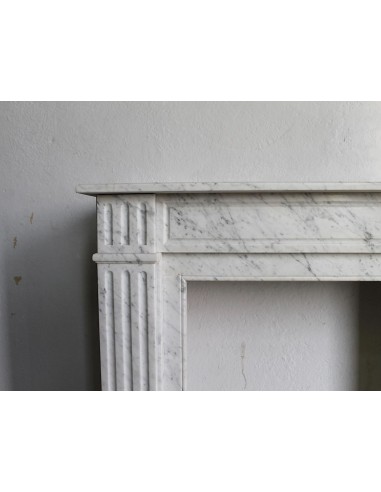LUIGI XVI CANNELURE, PARISIAN PROVENANCE, ITALIAN BILL, NAPOLEON III PERIOD, CARRARA WHITE WITH VEINING AS LIGHT AS HAIR, RESULT OF A CAREFUL SELECTION (detail, this, last on the list but worthy of great consideration because it determines the same difference as there is between a suit of good cut but of very bad cloth and one of equally good cut but made with the best Prince of Wales!)
More than once a year, although I consider myself firmly and incorruptibly a citizen of the Emilian lowlands between Modena and Reggio, I feel the call of the Fat, Cultured and Turreted Bologna. There are many reasons for this attraction and not only (as my wife claims) the plate of tagliatelle from that restaurant under the two towers (IL PELLICANO) or the trolley of boiled meats from the other restaurant at the beginning of Via Indipendenza (IL DIANA). I am attracted by what were the places of my studies (and consequently, of my youth), by the good-natured manner that you will always find on the face of the Bolognese from whom you have just asked for information, by the medieval walls of the historic center, so reassuring and steeped in history that you seem to absorb it, this history, just by walking past.
Well, maybe you will laugh, but among the reasons for my “fatal attraction,” there is one, apparently of little importance, that for me instead has much importance:
In Bologna you can still find a fair number of those old stores that have disappeared elsewhere, the same ones from half a century ago, with those carved wooden windows, with those signs like “Tessuti Nanni & figli,” stores that sell the same things from half a century ago, Majani's cremini (the legendary FIAT triple chocolate layer) or Baratti candies. And again, stores that have remained untouched at least since the postwar period, in which they sell horse maintenance accessories or mortadella made as God intended.
In this regard, I can tell you that when Pasquini closed (it produced, obviously artisanally, the best mortadella on earth) two irrepressible tears came down my eyes. An irreplaceable loss.
Here, these old stores in Bologna are for me a return to a cleaner, honest, fragrant, REAL past, a kind of warm cantuccio lined with walnut doors and brass knobs, beech counters and regulatory backroom whose entrance was, always, a flowery curtain, nothing to do with the modern “open space” with those lunar furnishings dazzling with light and blaring music, establishments devoid of thoughtful and “aproned” clerks, replaced by clerks/shopkeepers with near-zero knowledge of the object or product to be sold. In restaurants, bars or boutiques, then, what counts is the leg uncovering and the 10 heel, the rest is unimportant.
In this transition from the stores of yesteryear to modern commercial/recreational activities, there has been the hand of a swarm of crazy, alienated, “modern at all costs” architects but also the little (if any) culture of modern shoppers, who have not at all rebelled against this distorted and insane consumerism.
Remember that, going on like this, we will hand over the keys of the world to the masters of Amazon and Similar Monsters, who will mangle our brains more and more, until it is mush incapable of producing any thought, even the most basic.
Why did I write this long foreword?
What does all my above rant have to do with the fireplace mantel I am presenting here?
It has to do with it in that even in the world of the antique fireplace there may be the germ of our salvation, just as there was in the store of the beloved Pasquini.
Today you have a choice whether to follow modernity (Amazon etc..) by buying an industrial product produced in China or Viet Nam in a million or to make a unique piece your own, because ALL antique fireplaces, even if belonging to the most commercially successful models, are to be considered unique pieces.
Each sculptor, in fact, had “his” particular model of Cannelure, for some detail different from that of another master, and in any case each part of this fireplace was made by hand and polished by hand, an operation, the latter of polishing, that engaged a “polisher” (this figure was something more than a simple apprentice, because polishing was also an art and it took lustres of apprenticeship before becoming a “master polisher”) for several days.
IN SHORT, EVERY FIREPLACE CARVED UP TO THE VERY FIRST DECADES OF THE TWENTIETH CENTURY IS TO BE CONSIDERED A WORK OF ART (BECAUSE OF ITS DESIGN) AND HIGH CRAFTSMANSHIP (BECAUSE OF ITS MAKING), NOTHING TO DO, EVEN REMOTELY, WITH THE PRODUCTS OF LATER PERIODS.
PONDER ABOUT THIS. PONDER.










































































